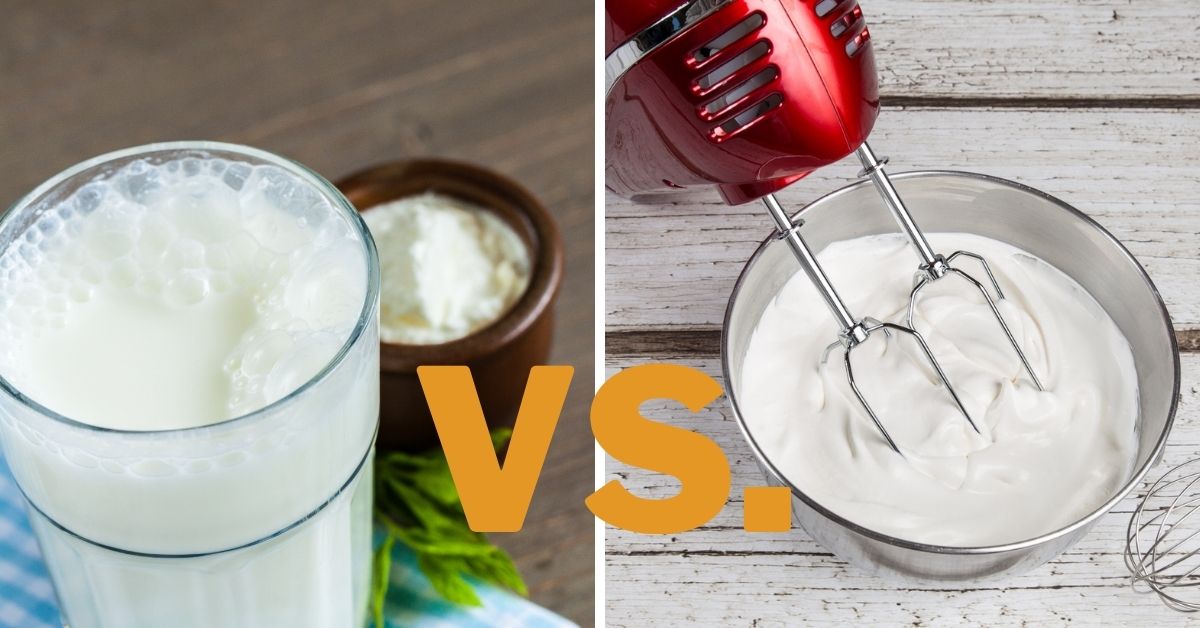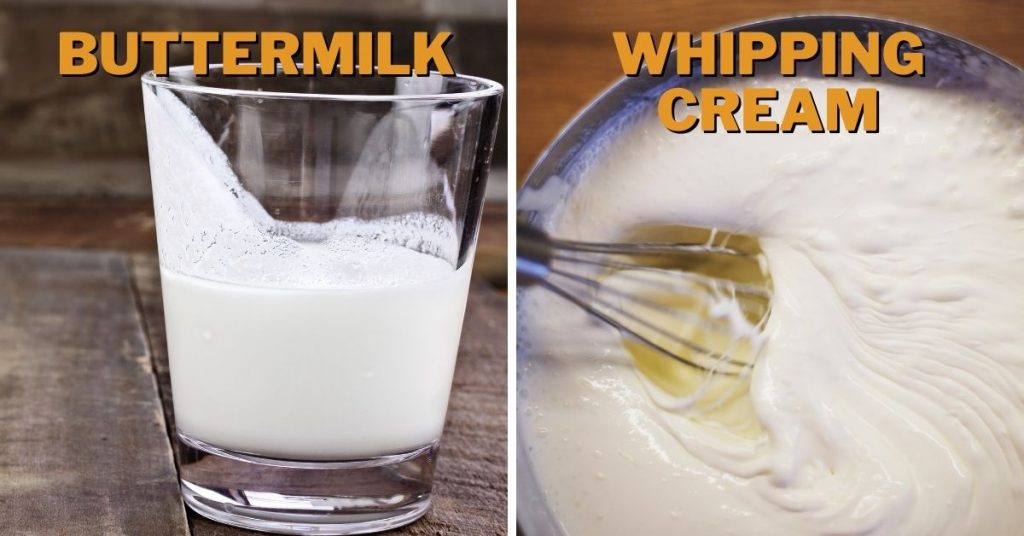Buttermilk vs. Whipping Cream: Differences & Uses

The massive family of dairies nowadays is increasing more and more, and sometimes the usage of some products can confuse consumers. One of those cases is buttermilk and whipping cream. Some people think they are the same, some don’t know the difference or mix them. So, what is the difference between buttermilk and whipping cream, and which one to use?
Buttermilk is a dairy product used mostly to make pastry fluffy and soft while baking, and whipping cream is used more as a filling in desserts or to decorate them. Also, buttermilk has a sour and tangy taste, while whipping cream is sweet and soft.
As you may see, besides the raw material in both is milk, buttermilk, and heavy cream are very different in production, organoleptic attributes, and way of use. So let’s end all your questions today and have a look at some important properties to compare.
Buttermilk vs. Whipping Cream: Differences
Buttermilk is made by adding lactic acid bacteria to milk, is a low-fat dairy, and has a tangy taste. Mainly buttermilk is used for baking cakes, biscuits, or other pastry in its liquid form.
Whipping cream is mostly oil or water emulsion that is stable to storage and comes from skimming this fat from non-homogenized milk. To obtain the final product, you need to whip the cream, usually with an electronic mixer for some minutes. This type of dairy is sweet and creamy and mainly used to fill in desserts or toppings.
Nutrition
Whipping cream, also known as light cream, has a high content of fat, which is 30-36%. Note that if the cream has a higher fat content than 36% according to regulation, it is considered heavy cream. Slight differences as the usage of them are very similar, but in case you worry about the fat content of your diet routine, now you know 🙂
If you consume whipping cream for a portion of 60gr, you will get 154.2 calories. When talking about vitamins, this product contains small quantities of 1-2% of vitamins B, D, E, K, and the most dominant one is vitamin A with 13%. Although I would advise being careful with consummation as I already explained is a bomb of calories and cholesterol.
On the other hand, consumption of buttermilk is believed to lower the level of cholesterol in our bodies due to a small level of fat; only 3 grams per cup, more than 3 times less than whole milk. [1] If compared with whipping cream both fat level and overall calories are even lower.
Regarding health benefits, U.S Deparment of Agriculture USDA claims that this product has a lot of vitamins that can bring health benefits to our bodies, like calcium, iron and magnesium. [2]
Texture
Whipping cream, in its original form, is liquid and non-homogenized. When beaten for 2-3 minutes at a moderately high speed, it reaches the uniform mixture of a fluffy foam desired by consumers. The cream at this point goes double the volume of the original liquid. For the cream to be in the right texture, you should leave it cool to a low temperature of around 5°C.
Buttermilk, even in texture, is very different from whipping cream. It is also a liquid but thinner. Although, at first sight, it may be mistaken with whole milk, as they look very similar, buttermilk has a more yellow shade. Sometimes it contains some small lumps and clumps, but if you see their presence increasing, this is a sign that the buttermilk is going bad.

Shelf Life
The temperature of 5°C helps the proper texture to be stable and extends the shelf life of the cream. If refrigerated, the whipping cream can last 1-2 weeks, although I prefer to consume it within a maximum of 10 days. Please consider not storing it in the fridge door, as in this part of the fridge, the temperature tends to be warmer.
Despite this, it is essential to mention that because of its composition, the foam stability won’t remain the same, and the volume may decrease a little immediately after several hours of processing.
When talking about buttermilk, the best part is that you can freeze it to make it last for up to 3 months, even after opening it. But even if you don’t prefer to do it, this product has the advantage that it can last longer than other dairy products; you only need to shake it if it has stayed in the fridge for some days already.
Taste
If you want to understand the differences in taste, think about them like this: whipping cream has a sweet, soft, and creamier taste, while buttermilk has a more sour and acidic taste similar to cheese flavor.
Uses
You can use both whipping cream and buttermilk in patisserie but with different ways and techniques. Most of the time, whipping cream is the last touch you give to your cakes, cookies, pastries, or pies after they are baked, as a topping, decoration, or filling. You can add chocolate, cacao, or other additives to give this cream another flavor. whipping cream can also be used in hot chocolate or pancakes as it contains its appropriate stability.
Buttermilk, on the other hand, cannot be whipped, so it usually cannot be used as filling or topping for any of the mentioned desserts. But, it still has a lot of excellent functions. Keep reading! Many bakers choose this dairy product to bake their pancakes, muffins, or cakes, as it makes everything fluffy and soft but also a little sour like a lemon taste. Because of that, buttermilk can be used in patisserie and as salad dressings, soups, or different dishes.
Let’s see below some recipes and my suggestions if those recipes work better with whipping cream or buttermilk.
| The recipe | Whipping cream | Buttermilk |
|---|---|---|
| Biscuits | X | |
| Fried chicken | X | X |
| Scones | X | X |
| Cake | X | X |
| Cornbread | X | |
| Ganache | X | |
| Frosting | X | |
| Dip | X | |
| Meat sauce | X | |
| Omelet | X | |
| Frosting | X | |
| Pasta | X |
Can You Use Whipping Cream and Buttermilk Interchangeably?
You can use whipping cream and buttermilk interchangeably, but it’s not that easy or common.
As already explained, those two products are different in composition and function in the recipe. Firstly, buttermilk is low in fat and calories, while whipping cream has significantly more. Think if you want a light recipe or something heavier.
If you want something lighter, still, buttermilk may not be the best option for you if you’re going to use it as a filling because buttermilk cannot be whipped. So if you want cream in your recipe, this is not what you are looking for.
In the case of a cake or muffin, consider that buttermilk has a leaving effect and makes the cake rise, which is a fundamental component of quality. However, the whipping cream does not have that effect, so interchanging those two ingredients will not be pleasant.
Lastly, don’t forget the difference in taste: buttermilk has a sour and tangy flavor, while the whipping cream is sweet and creamy. If one of those tastes is essential for the recipe, this interchange is not the best solution.
Can You Mix Whipping Cream and Buttercream?
I would say that whipping cream and buttermilk are not the best ingredients to combine in a mixture.
There are plenty of products in the food market today that we can add to our recipes to maximize the flavor and the final result, so if you are not strictly obliged to do it, then don’t. Still, in case you want to challenge yourself while mixing them, keep in mind two major factors I mentioned above:
1. If you want to whip them together, buttermilk will make the volume of the cream decrease, and
2. Whipping cream does not act as a leavening agent, so be careful with the quantity while mixing in cakes or biscuits to bake.
